Cross-Channel Marketing: Scaling Growth with Paid Search and Social Advertising
Share:
A cross-channel marketing strategy has become a vital piece of the performance marketing puzzle. Over 73% of consumers shop on more than one channel, so nurturing them through multiple channels is key to guiding them to purchase.
Forming a connection with customers across various channels and understanding how they shop can help you not only create a more seamless experience but find what makes your audience tick – so you can deliver a hyper-relevant marketing and user experience.
The ongoing shift towards a more privacy-first world only increases the importance of a cross-channel approach that markets to the entire customer journey. Industry changes like the iOS14.5 update are changing targeting, measurement, and attribution for advertisers even as online shopping grows by double-digit percentages every year by over 44% in 2020 due to the pandemic.
These privacy restrictions mean that marketers no longer can directly track all advertising through to the final conversion. With less ability to optimize the entire funnel to a measurable performance KPI, it’s more important than ever to take a strategic approach to influence the customer journey. Let’s walk through how you can drive new customer acquisition and get the highest value out of customers across multiple purchases to see growth in online performance marketing.
Setting the Cross-Channel Stage
To illustrate the significance of this process, let’s walk through a realistic customer journey. Meet Andrew, a new 31-year-old dad from Austin, TX, who is in the market for a fresh new outfit. An apparel retailer can speak to Andrew across multiple interactions to earn his trust and loyalty as a customer and maximize lifetime value.
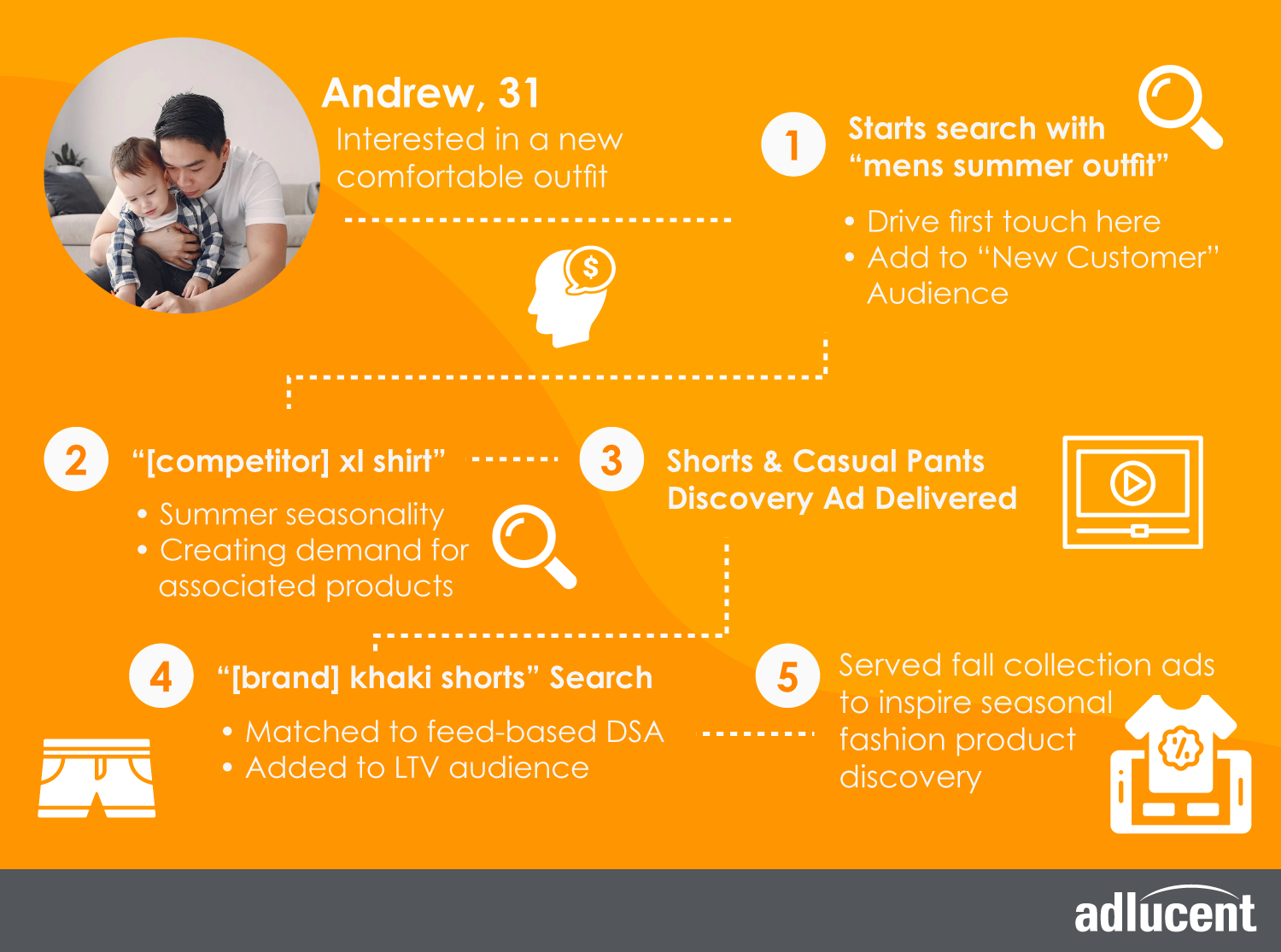
This illustration shows a multi-purchase journey he is taking with our client, a men’s apparel retailer.
To move Andrew down the funnel, understanding the types of clothing the client sells is important for finding the proper channels to:
- Drive awareness and conversion for an initial purchase
- Cross-selling by retargeting him
- Driving loyalty further downstream in the client’s mobile app
Taking this view of Andrew’s journey and relationship with the retailer allows us to market to customers with the right messages on the proper channels.
Upper Funnel: Building Strategies and Campaigns for Scale on Facebook
Social is an area that opens up many opportunities for brands and retailers because it’s a place where people engage with a variety of content. With social advertising, you’ll want to utilize first- and third-party signals to deliver your differentiated messaging and drive brand discovery.
A science-based approach that leverages social creative testing, can help you uncover what messaging is truly resonating with your audience. This process begins with identifying your objective that supports your business goal.
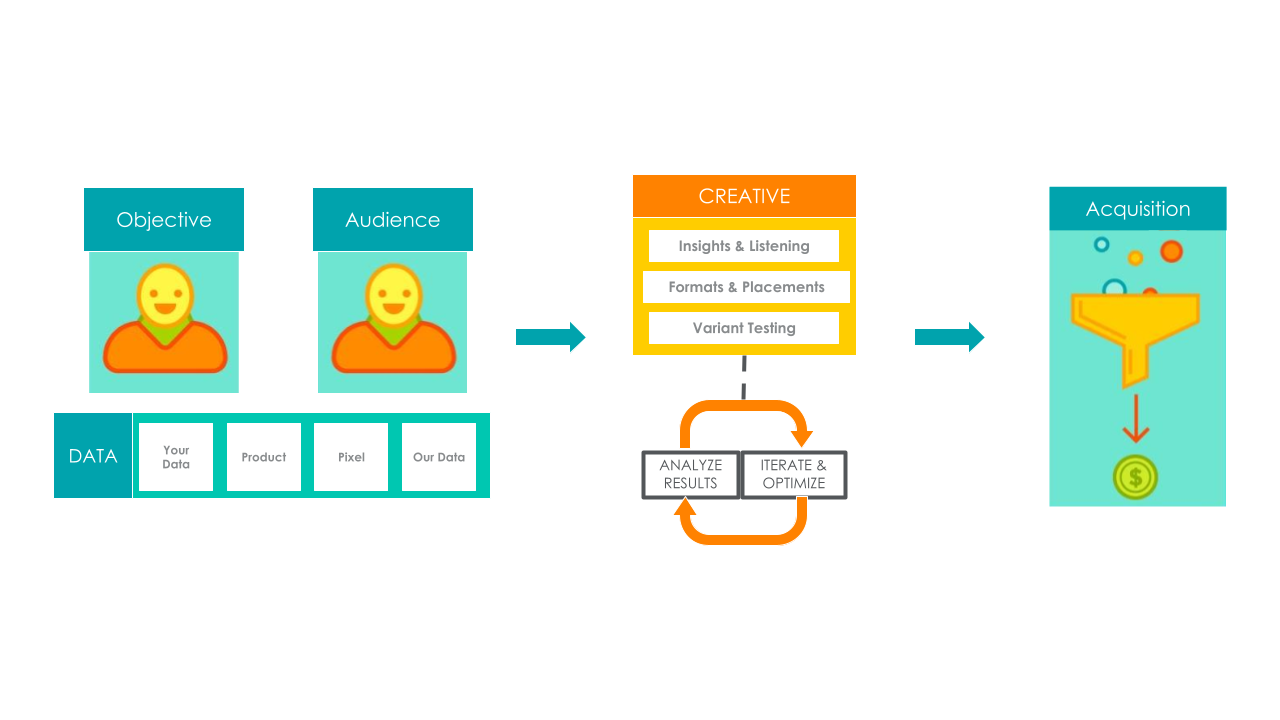
Goals could be “increasing new customer acquisition” or “growing purchases.” Then, drill into who your target audience is and what communication elements might motivate them to take the next step in their shopping journey. A robust creative testing process then allows you to understand the performance of these messages, identify winners, and inform the next round of creative development.
Get more creative and use it as a means of differentiation to drive brand discovery while shifting focus from a niche to broad appeal. By identifying & testing new customers and delivering appealing creative, you can develop demand and scale growth for lower-funnel campaigns.
Nurturing: Social Dynamic Product Delivery
After capturing your customer by engaging them with your creative, the next step is to nurture that intent through retargeting them using placements like dynamic product ads. These ads allow you to resurface products that they’ve been looking at on their website.

For example, showing Andrew clothing that he’s been having his eyes on but hasn’t yet committed to clicking the buy button in his cart. You’ll want to further his consideration and lead him to purchase while nurturing him through the funnel.
Identifying Paid Search Keywords and Products to Optimize
Many shoppers turn to search when they are ready to make the final purchase. Get in front of your customers when they’re searching for bottom-funnel terms that indicate a high intent purchase through Text Ads and Shopping Ads. What are paid search customer behaviors to monitor?
- Specific products customers are searching for
- Competitor product searches
- Physical store location searches
Andrew may be searching for a competitor’s clothing or expressing local intent, such as shopping in-store. Even as the industry shifts to be more digital-first, we know that customers who come into stores can be more valuable, as the in-store experience exposes them to more products and drives home benefits like convenience and easy returns. When possible, you should leverage these opportunities by conquesting against competitor brands and highlighting your in-store experience when relevant.
One powerful approach to this is properly leveraging Local Inventory Ads and incorporating your offline purchase and inventory data to drive local campaign performance alongside ecommerce. Informing searchers that you have the item in stock and of options like Buy Online Pick-up In-Store or Curbside Pickup are powerful ways to deliver a competitive message in the search engine results. This can be accomplished through a well-optimized product feed.
Optimizing Feeds for Relevance & Reach
Optimizing your product feed is essential today due to the importance of campaign types leveraging these feeds. Feed management is an integral approach to influencing and optimizing campaigns at scale, especially the automated campaign types becoming increasingly important. Having a clean and high-quality product feed that incorporates your first-party data will help your paid program run more efficiently.
Many pieces of data can help you better understand and optimize your product-level performance. These include:
- Margins
- Customer Lifetime Value (CLV)
- Customer Value Score
In addition, ensure you are promoting all of your top products in your Product Listing Ads (PLAs). Optimize your titles and descriptions with keywords your customers are looking for. These optimizations can boost the performance of your feed-driven shopping and dynamic campaigns.
Product Data: Enhance the Customer Experience and Prevent Wasted Ad Budget
Another way to improve your product feeds is by checking if your product data is normalized correctly and optimized for the channel that you are in.
- Google Merchant Center Feeds: In this feed, emphasize your retail brand and trademark brand (if applicable). You’ll want merchant feeds to have your brand name in the product title because it will drive query matching against extremely high purchase intent searches for those specific products.
- Facebook Product Feeds: On the other hand, for Facebook, this isn’t necessary. When you have a Facebook ad, your brand logo and name are displayed in the upper left corner of every ad because it’s a post. You wouldn’t want to emphasize your brand as much in the product title and reserve valuable real estate for product descriptions.
- Pinterest Product Feeds: Google may not focus on product category and type, but these fields still exist in the feed and can be valuable for Pinterest. If you are going to run a dynamic feed-driven product campaign on Pinterest, making sure that you are leveraging these fields that Facebook and Google are not looking at; is important for matching against search queries and optimizing your keyword buying approach on Pinterest. Keep in mind, Pinterest is often where people go when they don’t know exactly what they are looking for yet, which is why the platform has invested in robust text and visual search capabilities. Pinterest’s technology will analyze the deep semantics of your product images to deliver highly relevant results and inspiration through features like the “Related Pins” section, which is the most common way Pinners refine their search.
Quick Performance Tip: How Do I Prevent Wasted Ad Budget?
Make sure you’re serving your ads to the right audience. If someone is searching for a men’s shirt with a collar or a men’s cotton shirt with a specific color, you want to make sure to serve them something related. This type of feed optimization will give you control over delivering the right ad to the right person.
Restructure Your Catalog Campaigns
In addition to enhancing the content of your feed, using it to restructure your catalog campaigns at scale through categorization is a powerful way to control your spend better. By segmenting your shopping targets into relevant categories, you can allocate ad dollars based on your priorities and help surface the most important products to your most important customers – new or returning.
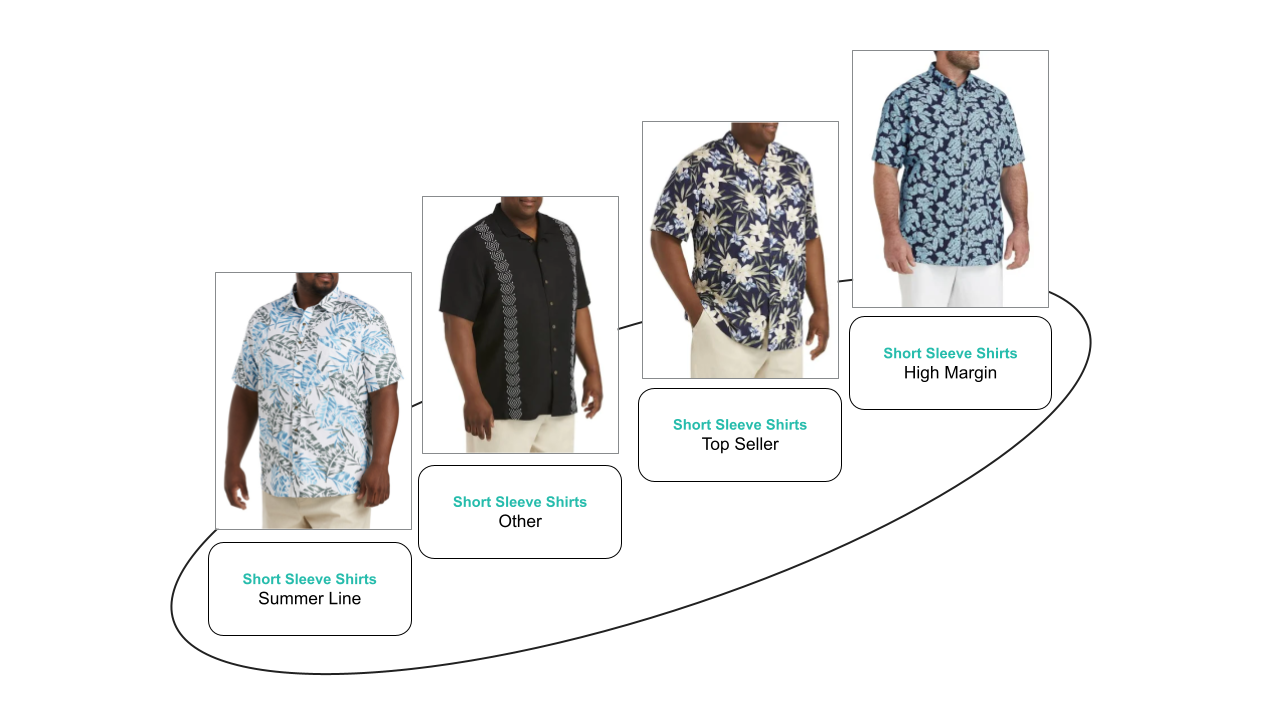
Segment your products into relevant categories by both performance and product type. Above, the retailer trying to sell to customers like Andrew grouped some of their top short sleeve shirts from their summer clothing line. They can group those shirts by performance. For example, the apparel retailer can take high-margin products and separate those from the top sellers.
You have the opportunity to label your products by top performance and group them appropriately in your feed, and use the feed to guide the structure of your paid search and social advertising shopping campaigns to serve the correct products together and bid to them correctly. You want to bid more for your high-margin products and less for low-margin products, even if they are both driving revenue.
Reaching Broad Audiences and Households Up the Funnel
So, now Andrew has his summer shirt in hand – which is excellent! But now, he’s considering completing the outfit with a new pair of shorts or another accessory.
After we’ve captured that initial purchase through that awareness campaign, followed up by conversion campaigns, you want to be thinking about continuing to advertise to the customer. One way you can achieve this is by retargeting your customers at the household level.

Andrew might not be on Pinterest a lot, but there is the opportunity to advertise to his wife, who loves to browse through Pins for inspiration. She may see something her husband might like to wear and show him – sparking new interest and potential purchase. After a customer’s browser has collected cookies, you could continue to promote relevant products to past customers and past site visitors, like Andrew, with ongoing offers for what’s in the market right now.
Scaling Non-Branded Paid Search
As Andrew himself continues his shopping journey for the next piece of his outfit, we have the opportunity to speak to him while he does research.
Beyond retargeting customers in social, it’s essential to scale non-brand search campaigns to drive growth – not only in shopping campaigns but also in keyword campaigns. This is where Adlucent sees a lot of value in leveraging automation and feed-based dynamic search ads (DSAs).
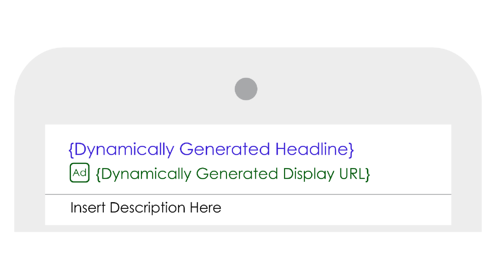
These campaigns operate by giving Google a landing page and then allowing Google to determine which keyword bids and ad copy are driving to that landing page. It’s similar to shopping campaigns where you are giving Google a product, and it’s determining which keywords and bids to target and serve to a customer.
With feed-based DSAs, we can take a similar approach to categorize, and labeling landing pages in the DSA feed as we do to products in the shopping feed. By taking this feed-based approach, rather than a URL-filter-based approach, we can get much more granular and specific and use data to optimize and categorize the pages in the feed.
Cross-Selling to Support Customer Lifetime Value
Once you’ve built audiences, support the entire catalog through cross-promotion. Incorporate more familiar messaging, less complexity, and different ROAS targets based on audience and product segment. Lean into ad types like display or discovery ads to make people better aware of your other products.
Review what your product life cycle tends to look like and relevant seasonality trends to take advantage of. For example, do you see an increase in jersey sales in the fall at the start of the football season? Make sure you have your campaign set up appropriately and retarget people that have purchased from you before. Build your customer loyalty campaigns to continue reaching out to Andrew to guide him into repeating the buying experience.
Focus on lifetime value by using custom conversions, such as:
- Repeat purchases
- In-store engagement
- Rewards club engagement
- App downloads
By understanding the values of these custom conversions that are valuable across multiple simultaneous shopping journeys for different products and purchases, retailers can more effectively optimize to blended value across these conversions, maximizing holistic success.
App Marketing and Rewards
We believe app marketing will also be an increasingly important channel for advertisers in the more privacy-forward future. Apps will be means to communicate with and retain your valuable customers, and additionally will be far more trackable from push notification to app engagement than advertising in other apps and browsers. This owned channel will provide continuous audience segment and consumer analytics to inform a relevant retention strategy and optimize demand gen campaigns.
If you have an app, it’s important to leverage the custom app campaign types in Google and Facebook, mobile measurement, and strategic creative testing to grow installs and usage.
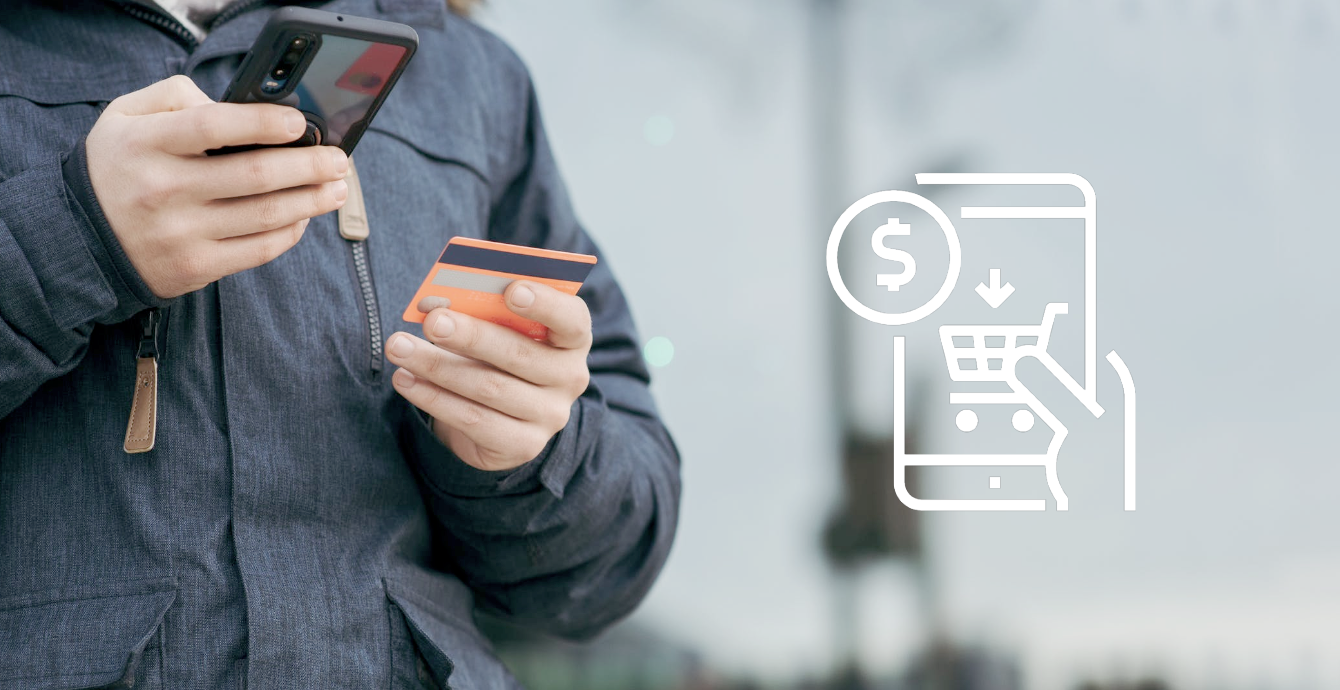
Model-Driven Planning™: Test and Measure Incremental Channel Impact
How are you measuring and ensuring that your upper-funnel campaigns get people engaged with your brand? To help answer these questions, we believe in understanding your data by using a scientific testing-based approach. The dream of perfect multi-touch attribution is dying, so in response, advertisers should look at technology-independent approaches of incrementality testing and lift mentality testing.
We designed an approach called Model-Driven Planning™ powered by our Lift Mentality tool. Lift mentality allows us to take your data, using your source of truth for business success, and create balanced geo splits for testing. Our typical approach is to split audiences into three geographies that are the same, allowing for a control group, a heavy-up group, and a reduced-budget group. This facilitates incremental lift testing at your existing budget investment level with minimal impact on campaigns. This approach enables brands to see opportunity costs and make data-driven decisions around campaign strategies.
Key Takeaways
- Drive growth with a full-funnel, cross-channel, multi-purchase view of how marketing impacts your customers’ journey
- Understand your campaign goals around awareness and purchase to ensure you’re optimizing to the correct goals and the best audiences and creative
- Utilize product and landing page feeds to better leverage your first-party data to drive groupings and optimize Shopping Ads, Text Ads, and Dynamic Product Ads
- Ensure you have a robust measurement approach and understand the correct KPIs for each channel and stage of the journey. As much as possible, optimize to customer value across all of your conversions
- Consider Incremental Lift Testing as a powerful tool for measuring the true value of your marketing and planning your full-funnel campaigns
As privacy regulations and technological evolution push the industry, opportunities for performance marketing and outperforming your competitors will increasingly come from cross-channel strategies that target the entire funnel. Taking a data-informed, science-based approach to these campaigns will be critical for retailers and advertisers to continue to drive business growth via performance marketing.
Watch part 4 of our Digital Learning Series – Creative Testing Best Practices that Prove a Better Click-Through Rate on demand. Learn more about taking a scientific approach to your advertising strategy with creative testing and reveal best practices to reach your target audience. Watch now!

Adlucent
Adlucent is the performance marketing agency that proves outperformance has no limit. Powered by our purpose-built platform, Deep Search™, Adlucent unifies the best of human and machine for a scientific approach to marketing. We work transparently in partnership with B2C and B2B retailers and brands to create custom, predictive programs that drive ever-better outcomes. Our services include paid search, shopping, social, retail media networks, display media, video, performance creative, consulting, and measurement. Headquartered in Austin, Texas, Adlucent is part of Advantage Solutions and ranked one of the top marketing companies in the U.S. by AdAge.
More Resources
Blog Post
January 9, 2025
Blog Post
October 9, 2024
10 Holiday Stats Every Retail Marketer Should Know
Discover 10 essential holiday shopping stats for retail marketers in 2024. Learn how to boost your campaigns with insights on omnichannel strategies, video ads, BNPL, and more."
Blog Post
September 5, 2024
Adlucent Awarded Google Marketing Platform Certified Partner Status, Strengthening Client Solutions
Adlucent, the performance media, analytics, and data agency that recently joined forces with BarkleyOKRP, is officially a Google Marketing Platform (GMP) Certified Partner for Display & Video 360 (DV360), Campaign Manager 360 (CM360), and Search Ads 360 (SA360).